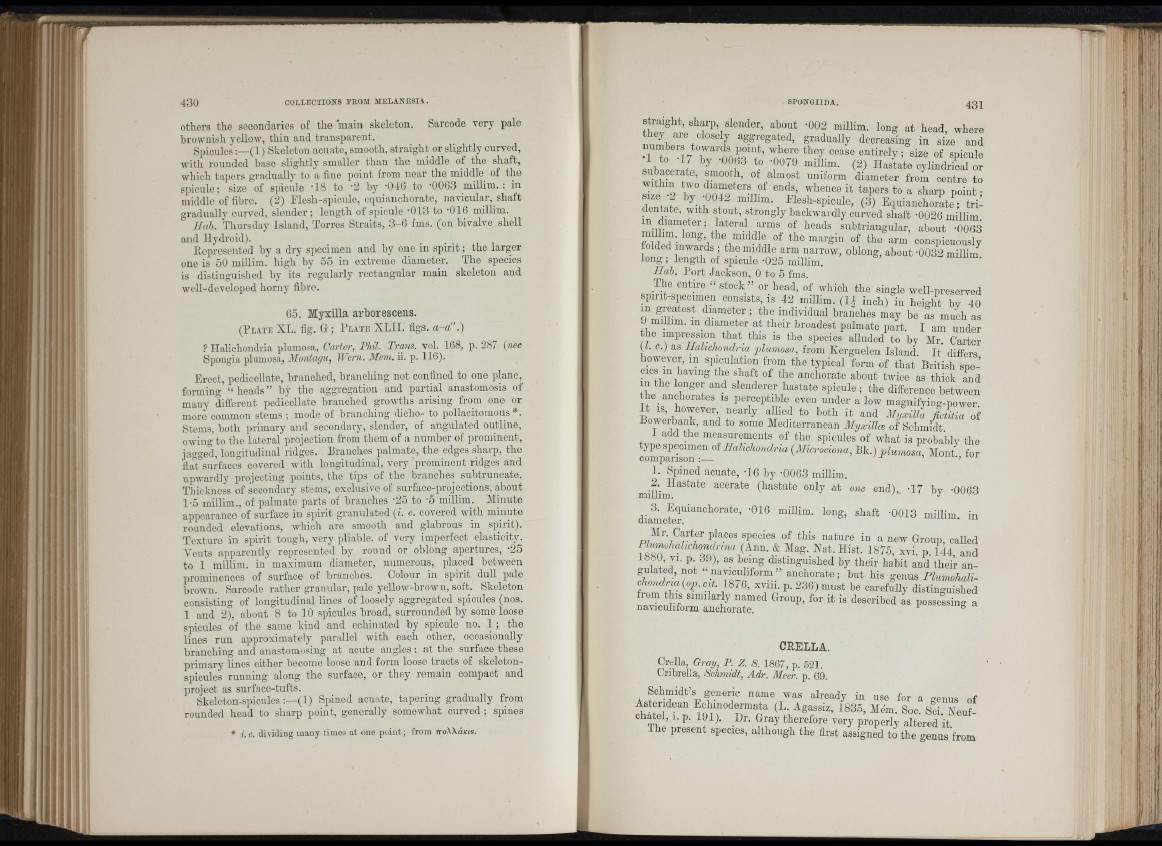
::
I .
i l l :
Hll'
i l l
ill
! I
i!te
t ' i i"
m il
! n '
?i ■i; :;
i ;
l i = • i i
! I
Ï ■' i '
Î I
t Î
J i
COLLECTIONS FROM MELANESIA.
others the secondaries of the main skeleton. Sarcode very pale
brownish yellow, thin and transparent.
Spicules:—(1) Skeleton acuate, smooth, straight or slightly curved,
with rounded base slightly smaller than the middle of the shaft,
which tapers gradually to a line point from near the middfe of the
spicule ; size of spicule 'IS to -2 by ’046 to '0063 millim. : in
middle of fibre. (2) Flesh-spicule, equianchorate, navicular, shaft
graduallj" curved, slender ; length of spicule ’013 to ‘016 millim.
JIab. Thursday Island, Torres Straits, 3 -0 fms. (on bivalve shell
and Hydroid).
liepresented by a dry specimen and by one in spirit ; the larger
one is 50 millim. high by 55 in extreme diameter. The species
is distinguished by its regularly rectangular main skeleton and
well-developed horny fibre.
65. Myxilla arborescens.
( P l a t e XL. fig. G ; P l a t e XL II. figs. a-a".)
? Halichondria plumosa, Carter, Phil. Trans, vol. 168, p. 287 (nec
Spongia plumosa, Montagu, Jl ern. Mem. ii. p. 116).
Erect, pedicellate, branched, branching not confined to one plane,
forming “ heads” by the aggregation and partial anastomosis of
many different pedicellate branched growths arising from one or
more common stems ; mode of branching dicho- to pollacitomous *.
Stems, both primary and secondary, slender, of angulated outline,
owing to the lateral projection from them of a number of prominent,
jagged, longitudinal ridges. Branches palmate, the edges sharp, the
fiat surfaces covered with longitudinal, very prominent ridges and
upwardly projecting points, the tips of the branches suhtruncate.
Thickness of secondary stems, exclusive of surface-projections, about
1-5 millim., of palmate parts of branches -25 to -5 miUim. Minute
appearance of surface in spirit granulated (i. e. covered with minute
rounded elevations, which are smooth and glabrous in spirit).
Texture in spirit tough, very pliable, of very imperfect elasticity.
Veuts apparently represented by round or oblong apertures, -25
to 1 millim. in maximum diameter, numerous, placed between
prominences of surface of branches. Colour in spirit dull pale
brown. Sarcode rather granular, pale yellow-brown, soft. Skeleton
consisting of longitudinal lines of loosely aggregated spicules (nos.
1 and 2), about 8 to 10 spicules broad, surrounded by some loose
spicules of the same kind and echinated by spicule no. 1 ; the
lines run approximately parallel with each other, occasionally
branching and anastomosing at acute angles ; at the surface these
primary lines either become loose and form loose tracts of skeleton-
spicules running along the surface, or they remain compact and
project as surface-tufts.
Skeleton-spicules;—(1) Spined acuate, tapering gradually from
rounded head to sharp point, generally somewhat curved ; spines
* i. e. dividing many times at one point ; from TroXXdicis.
straight, sharp slender, about -002 millim. long at head, where
S l v o t / gradually decreasing in size and
numhei towards point, w ^ of spicule
to 17 h j 0063 to -00/9 millim. (2) Hastate cylindrical or
subacerate, smooth, of almost uniform diameter from centre to
S e 2 p ^ ;
dentate J it6 f hlesh-spicule, (3) Equianchorate; tridentate,
with stout, strongly backwardly curved shaft -0026 millim
in diameter; lateral arms of heads subtriangular, about -0063
1 of the arm conspicuously
Ided inwanls ; the middle arm narrow, oblong, about -0032 millim
lo n g ; length of spicule -025 millim.
Hah. Port Jackson, 0 to 5 fms.
The entire “ stock ” or head, of which the single well-preserved
spirit-specimen consists, is 42 millim. ( 1 | inch) iu height by 40
m greatest diameter ; the individual branches may be as much as
9 miUim. m dianieter at their broadest palmate part. I am under
the impression that_ this is the species alluded to by Mr. Carter
(i. c.) as Matichonclna plumosa, from Kerguelen Island. I t differs
however, in spiculation from the typical form of th at British spe-’
in f ®i i anchorate about twice as thick and
in the longer and slenderer hastate spicule ; the difference between
the anchorates is perceptible even under a low magnifying-power
Bowerbank, and to some Mediterranean Mtjxillw of Schmidt
I add the measurements of the spicules of what is probably the
type specimen of Halichondria (iMicrociona, Bk.) plumosa, Mont for
comparison ;— ’ ’
1. Spined acuate, -16 by -0063 millim.
mifl'in?^^^^^^ acerate (hastate only a t one end),. -17 by -0063
diameter^^^” ^^^^'^^^’ “ iPim- long, shaft -0013 millim. in
Mr. Carter places species of this nature in a new Group, called
Hist. 1875, xvi. p. 144, and
1880, VI. p 39), as being distinguished by their habit and their angulated,
not ‘•navicnliform” anchorate; but his genus Plumohali-
clwmlrufiop. cit. 18/6, xvm. p. 236) must be carefully distinguished
u If;.
CRELLA.
Crella, Gray, P. Z. S. 1867, p. 521.
Cribrella, Schmidt, Adr. Meer. p. 69.
Schmidt’s generic name was already in use for a £?enus of
Asteridean Echinodermata (L. Agassiz, 1835, Mem. Soc. Sci Xeuf-
chatel, 1. p. 191). Dr. Gray therefore very properly altered it
The present species, although the first assigned to the genus from